Have you been inside a space that left you feeling tired, light-headed, or even nauseous? With the average American spending 90% of their time indoors, it’s important to consider the effects of indoor air quality – not only on our comfort, but also on our health. In fact, the EPA estimates that air pollutants are usually 2-5 times more concentrated indoors than they are in outdoor environments.
There are many factors that can affect the quality of indoor air, and few people understand how these things can truly impact a person’s well-being. Depending on the contaminant and the concentration, some air pollutants can cause lethargy, low productivity, respiratory issues, severe allergic reactions, cancer, and even death.
With asthma cases on the rise in the United States and the more immediate airborne nature of the COVID-19 pandemic, indoor air quality is now more of a pressing concern than ever.
That said, the task of improving indoor air quality has a lot of moving parts, with plenty of challenges for homes, schools, retail spaces, and office spaces alike. Luckily science and technology have helped us come a long way in making our air safer to breathe.
In this guide, we will cover some fundamentals of HVAC and indoor air quality, profile specific pollutants, and explain how to best protect against each one. We’ll also point you in the direction of some important technology that can help you make your indoor spaces safer for everyone.
The Basics of Indoor Air Quality
Before we dive into specifics, it’s important to discuss some of the basic science and proven techniques involved with maintaining healthy indoor air quality (IAQ). According to the EPA, IAQ focuses on “the quality of the air in a home, school, office, or other building environment.”
Good, fresh air is often described as clean and refreshing. That’s because breathing quality air wakes up our brains and makes us feel more awake. Poor quality air often makes us feel sleepy and stuffy.
Three Types of Pollutants
Poor indoor air quality is caused by pollutants that become concentrated in the air. Generally, there are three categories of pollutants that contaminate indoor air: biological, chemical, and combustion. We’ll cover more specific pollutants in each category later on. For now, it’s important to know the basic distinction between each one.
- Biological pollutants are contaminants that come from organic objects in the environment, such as mold, pollen, and viruses.
- Chemical pollutants include things like VOCs, lead, formaldehyde, and other carcinogens that originate from building materials and cleaning products.
- Combustion pollutants come from burning various fuels and include things like exhaust fumes, carbon monoxide, and smoke.
Testing

The basic goal for good indoor air quality is to either eliminate the source of a given pollutant or ventilate the space enough to dilute its presence in the air. Depending on the type and severity of the pollutant, you will likely need a combination of these solutions to treat the issue.
Most of the time, consumer-level testing can help homeowners and building managers make more informed decisions about what types of IAQ challenges they might face. While many home tests offer a cost-effective way to help you better understand your indoor environment, you will usually want to call a professional technician who can collect a good air sample.
No matter which type of pollutant you are testing for, it’s important to collect an air sample that is truly representative of your typical IAQ and free of outside particles that may skew the lab results later on. Usually an HVAC technician can help you collect a controlled sample and advise you regarding the ways you can improve your IAQ depending on the test results. Prices for home tests and technician services will vary depending on the type of pollutants you’re testing for and the company you choose to work with.
Because of this, it might not be a good idea to test for every pollutant you can think of in hopes of catching a single culprit. That approach would be incredibly expensive and time-consuming. Instead, start by checking for signs and symptoms of certain pollutants in your everyday building occupants. Increased drowsiness, difficulty breathing, allergies, and other symptoms can all point toward specific air contaminants. Also make sure you pay attention to the smell of the air. All smell is particulate, and while it may not be dangerous, a strange odor does usually indicate something foreign in the air.
Maintenance
Maintaining good indoor air quality requires frequent cleaning, repairing and maintenance of HVAC systems, and taking steps to weatherize your space during certain seasons. Even some of the smallest routine maintenance tasks can make a huge difference in air quality.
Regular cleaning and dusting of surfaces can keep spaces free of dust, pollen, dirt, and viruses that could otherwise hang in the air. This means cleaning your stoves, countertops, desks, tables, floors, bathtubs, and toilets often. Be sure to especially clean anything that’s close to a return air vent or supply vent. You don’t want dust or other particles to get sucked up into the vents and circulated throughout the building.
Still, this is bound to happen at some point and you can curb some of the effects by cleaning your ducts as well. Be sure to remove any dust or obstructions so that air can move quickly through the ducts.
Beyond that, it’s important to maintain the integrity of the ductwork and vents by fixing any leaks, sealing off edges and cracks, and repairing any broken vents. You also want to be sure that you place your vents in the right place when reworking an existing system, and change your filters often. We will talk more about ventilation and filtration in depth later on.
You can then take additional steps to weatherize your buildings during winter months by adding weather stripping beneath doors and around windows where air can enter and escape. Blown-in wall insulation and storm windows also help by maintaining control of the airflow and making sure outside pollutants do not enter the space. Not that more ventilation is bad, but uncontrolled or unintentional ventilation (such as from leaks) is often counterproductive.
Regulations for Indoor Air Quality
While there aren’t many legal mandates when it comes to indoor air quality, there are a few standards that you may or may not need to meet for your building to be up to code.
Perhaps the most relevant set of regulations is the EPA’s National Ambient Air Quality Standards. The NAAQS is a set of standards created by the EPA to designate six types of common air pollutants that are known to be harmful to humans. Carbon monoxide, lead, particulate matter, ozone, nitrogen dioxide, and sulfur dioxide all have their own pages on the EPA website. While there are certainly more pollutants to consider aside from these, this is a good place to start.
These standards set limits for how much of a pollutant can be present in a given space (such as residential or commercial) for a certain period of time (i.e. a 24-hour period) in order for the indoor air to be considered safe.
For example, particulate matter is considered especially dangerous because pollutants in this category are small enough to enter the lungs and bloodstream, causing major damage. These are particles that are smaller than 2.5 μm in diameter. The NAAQS limits particulate matter to 25 μg/m3, based on 24 hours of data.
You can also use OSHA guidelines to help you maintain good indoor air quality in other spaces. However, there are no official legal requirements for indoor air quality under OSHA guidelines except in California and New Jersey. Still, there is good information available that can help employers improve IAQ in the workplace.
Specific Pollutants and How to Deal With Them
Different pollutants affect the air quality in ways that might surprise you. It’s important to understand how each pollutant works so that you can safely and effectively eliminate them from your indoor space. While some require technicians for safety reasons, some can be fixed with simple ventilation and cleaning measures. Let’s look at each one in depth.
Mold
It’s likely that some mold is present in almost any indoor environment. While low levels are not usually harmful, higher concentrations of mold can cause allergic reactions, poor lung health, and infertility in some cases. Mold infiltrates the air when large concentrations release spores into the surrounding area. These spores can travel through vents, spread throughout the house, and even stick to your clothing.
Mold is usually found in tight, damp spaces such as underneath kitchen sinks, in bathtubs or showers, and sometimes in attics or walls that contain piping. When moisture and poor ventilation come together, you typically find mold.
To eliminate mold spores from your indoor air, you want to focus on treating the molded area directly. If you are unsure what type of mold you have, you can conduct home tests. However if the mold is already visible, it can be difficult, as different types of spores may confuse test results. In any case, it’s best to wear a mask and gloves when cleaning the mold or call a professional to have it removed.
Once you have cleaned up the mold itself, you will need to fix the problem that made the area moldy in the first place. Whether that’s a leaky faucet or a hole in the roof, make sure to complete the proper repairs and ventilate the area at least temporarily until you remove the mold and get rid of spores in the air. If mold has gotten into any boards or carpets, it’s best to replace them entirely.
Asbestos
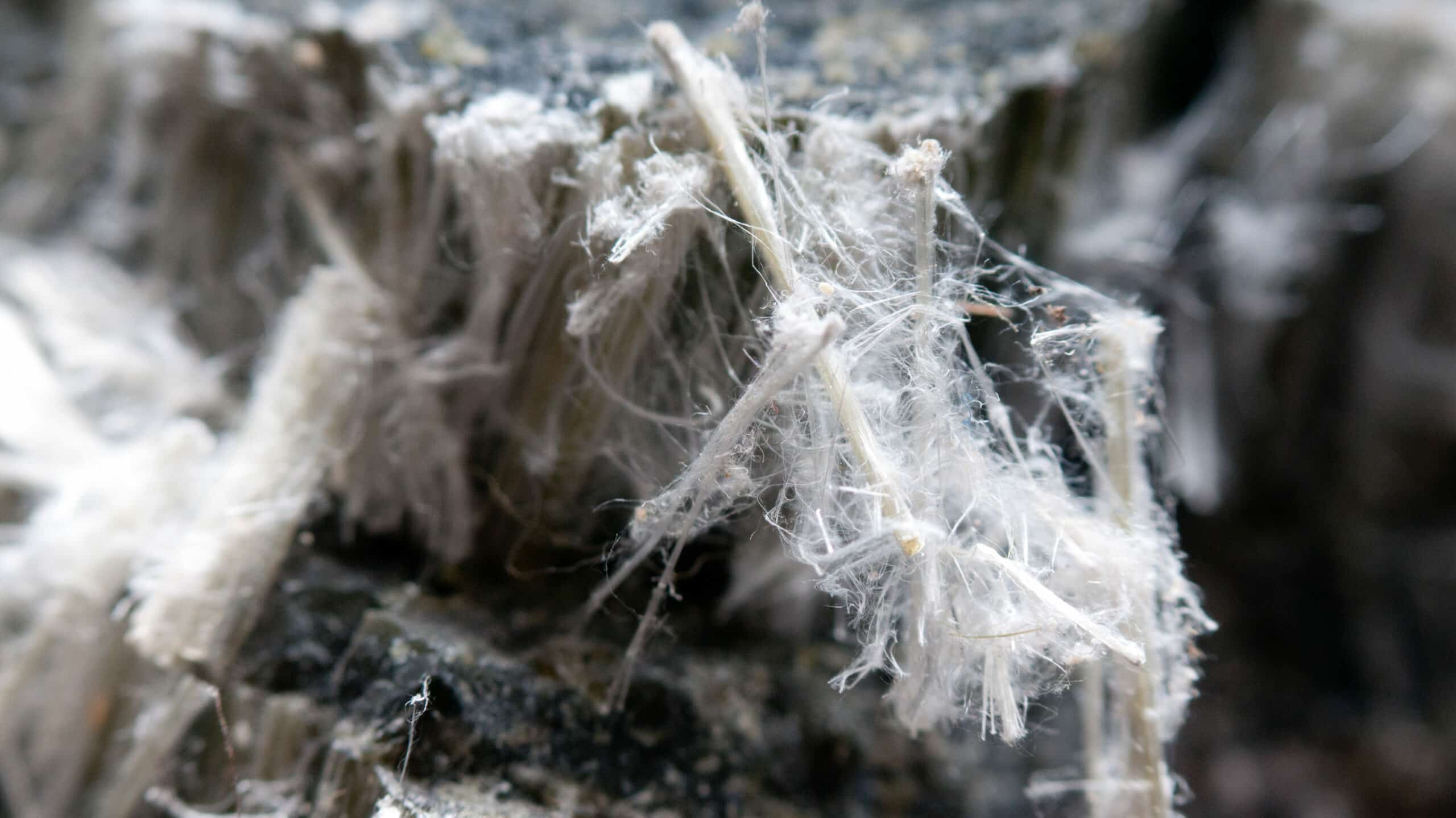
Asbestos is a naturally occurring material that also happens to be good for insulating things like walls and pipes. This is because it is resistant to heat and electricity. When infused with other building materials, it can also make things stronger. For this reason, asbestos was commonly found in buildings and homes between 1920 and 1970.
As it turns out, asbestos can release particles into the air that severely damage the lungs. Prolonged exposure over time can cause lung damage and mesothelioma. Because of this, the United States banned the use of spray asbestos and some other forms of the material.
To get rid of this type of pollutant, you want to remove the asbestos from the house as soon as possible. However this is never something you should try to handle yourself. Always contact a professional to safely remove asbestos from your home, school, or office building. If you cut into or rip out asbestos without proper care, it can immediately release cancer-causing particles into the air around you.
Smoke/Combustion
Combustion pollutants are caused by burning fuels or other materials that then release chemicals or exhaust fumes into the air. These include things like smoke from fireplaces, tobacco smoke, exhaust fumes, and carbon monoxide (more on that later).
If you or someone you know smokes inside, that smoke can not only stick in the air for a long time and infect the lungs of those breathing it, but it can also stick to walls, carpets, clothing, and furniture. The same dangerous particles found in cigarettes can trap and release secondhand smoke into the air. This type of smoke has 4000 different compounds in it, 40 of which are known carcinogens that can cause asthma, bronchitis, and cancer in children and adults. For this reason, it’s best to make sure anyone who smokes always does so outside.
Aside from that, smoke from fireplaces or wood-burning stoves can also cause poor indoor air quality. Even though it may seem nice to sit by a wood fire in the evening, it’s not good to breathe in the smoke.
However, this doesn’t mean you have to get rid of your wood fireplace or wood-burning stove. Simply take care to properly ventilate the smoke from those sources so that you don’t breathe it in. Be sure the flue and chimney are cleaned regularly by a professional and are free from any obstructions. Never ventilate the smoke directly into your home. Often in the case of housefires, it is the smoke that kills occupants before the fire itself.
Carbon Monoxide
Other combustion pollutants like carbon monoxide result from things like car exhaust fumes, kerosene or gas heaters, stoves, and even dryers. Because carbon monoxide is colorless and odorless, it can be nearly impossible to know if it is in your air without a CO detector. Luckily, this type of device typically comes standard with many homes and may even be a dual function of your smoke alarm.
While no amount of carbon monoxide is really good for you, high concentrations can kill you. People have been known to die in their sleep from CO poisoning without ever waking up. When awake, signs such as dizziness, shortness of breath, weakness, nausea, and loss of consciousness can indicate the presence of CO in the air.
Often, you don’t need to do anything more than ventilate the space to make it safe to breathe again. If you allow the carbon monoxide to safely escape the home at an acceptable rate, dryers, heaters, and gas stoves are safe enough to use inside.
Ozone / Nitrogen Oxides
When found in the upper atmosphere of the earth, ozone shields us from harmful UV radiation. However, ozone found in areas where we breathe (otherwise known as tropospheric ozone) can be truly hazardous. Not only can it make existing diseases like asthma and emphysema much worse, it can also cause chronic lung damage and cardiovascular damage.
Indoor or tropospheric ozone is created when VOCs and nitrogen oxides react together with sunlight and heat. These can emit from things like pesticides and paints as well as vehicle fumes, stored fuels, and other common household chemicals. Nitrogen oxides are created from burning fossil fuels. Even something as simple as using a chemical containing VOCs can create a small cloud of indoor ozone.
To prevent ozone pollution for indoor air, be sure to read chemical labels carefully. Try to avoid products with VOCs. Ventilate any areas where chemicals containing VOCs are necessary, and change air filters regularly.
VOCs
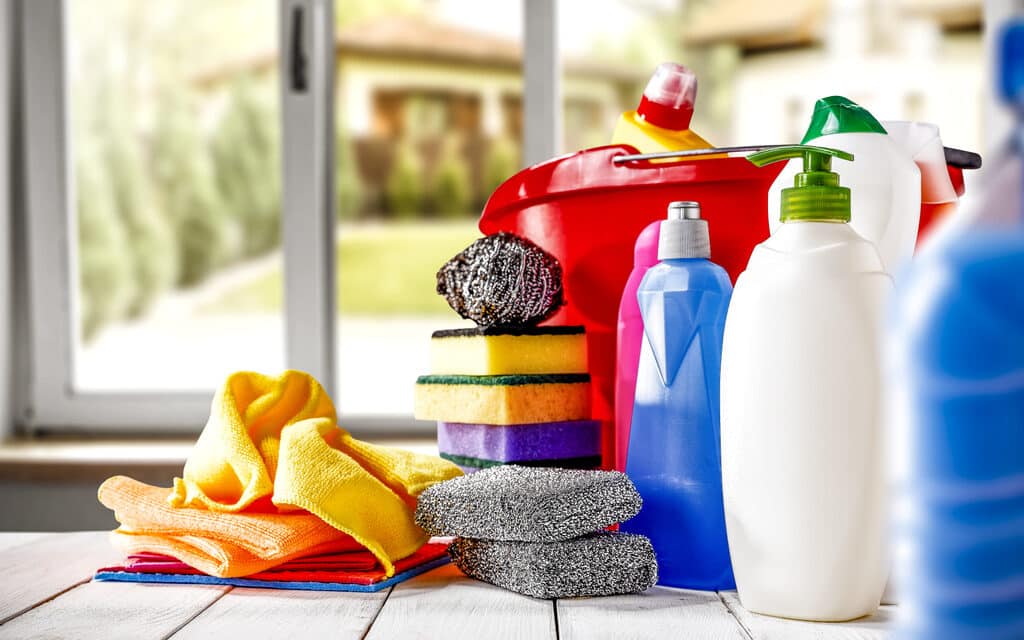
Volatile Organic Compounds (VOCs) are typically carbon-based synthetic compounds that can quickly evaporate into gases. This makes them especially dangerous for indoor air quality. Symptoms of VOC exposure include allergic reactions, respiratory issues, skin reactions, memory loss, and loss of coordination.
While many VOCs will be man-made (synthetic), some are found to occur naturally. Lead, formaldehyde, and radon are all fairly common VOCs, but there are many others such as benzene and perchloroethylene which can be just as harmful. VOCs can be found in things like air fresheners, cleaning chemicals, paint, stored fuels, preservatives, and even dry-cleaned clothing.
Ideally, we should all use alternative versions of these products that do not contain VOCs. However, it can be difficult to find them on the market for a good price. Instead, when using these products, be sure to ventilate the area well and follow the instructions on the label closely. Try to do any required mixing of cleaning chemicals or pesticides outside, away from open windows or doors. When finished, dispose of wasted product properly and according to the label. Be sure to store any household cleaning chemicals or other products containing VOCs away from return air vents so that it does not get distributed through the building.
Formaldehyde
There are a lot of different materials that can contain formaldehyde, and some of them are surprising. Most often, formaldehyde is used as a preservative for building materials such as pressed wood, particleboard, insulation, and plywood. It can also be found in glues and other types of coatings or sealants. Usually formaldehyde has a strong smell, but if it is in a place that you don’t normally access (such as an attic), you may not know it’s there.
As a known VOC, formaldehyde can cause irritation to the eyes, nose, and throat right away. However, prolonged exposure can cause cancer.
To remove formaldehyde from your indoor air, it is best to remove it from the source and ventilate the area by opening a window and using a fan. You may also try to make use of formaldehyde-free products instead to prevent future contamination.
Lead
Lead is a chemical pollutant that can cause serious damage, especially when released into the air. According to the World Health Organization, any amount of lead exposure is considered dangerous. Especially in children, lead can cause brain damage, comas, convulsions, and even death, among other things. While many consumer products and building materials have discontinued the use of lead, lead-based paint is still a major concern for houses built before 1970.
If your home still has lead-based paint, any cracks or breakage can cause lead dust to be released into the air. Even though the United States passed many laws that reduce the presence of lead in homes, some sources may still be present. The best way to know if you have a lead issue is to have your home or building inspected by a professional.
To prevent lead from contaminating your home, it would be ideal to remove the lead paint entirely. However, you should always contact a professional to do this. They will take the proper precautions by wearing specialized masks and ventilating the area away from occupants. These same professionals can sometimes use a HEPA filter vacuum to remove lead particles directly from the air, if already released. In any case, you should never try to remove lead paint or lead dust by yourself.
If you enter an area where lead dust is present, be sure to remove your clothes and shoes and wash your hands thoroughly before entering a new space. This will prevent particles from transferring over.
If you have no way to remove lead from the area, be sure to wash your hands and your children’s hands often. Wash play areas and toys with soap and water frequently to prevent contamination.
Radon
Radon is a radioactive gas that enters homes and other buildings through the ground. When radon enters the air, you are literally breathing in radioactive chemicals. In fact, it is the second leading cause of lung cancer in the United States.
Usually, radon infiltrates a space through cracks in the foundation or walls that touch the ground. To test for radon, home improvement stores usually carry consumer tests that will give you some pretty accurate results. Most of these tests will require you to put the monitor in a single area for a long period of time (sometimes 30 to 60 days). It will then measure the presence of radon over time to gauge the level of the problem.
If your home, school, or office building has a radon issue, you will likely need to contact a professional as it can be hard to get rid of the issue on your own. Typically solutions include sealing cracks in the foundation, insulating or repairing leaks in walls, or using a vent pipe system and a fan to remove the contaminant.
Dust and Pet Dander

While not necessarily deadly, dust and pet dander can make the indoor air in a space very unpleasant to breathe. They can also trigger allergies and make one feel sluggish and develop a cough.
The best way to prevent dust and pet dander from entering your air is to vacuum/shampoo your carpets. Be sure to use a damp rag and a vacuum to dust/clean your surfaces and appliances on a regular basis. To remove dust mites, wash bed sheets in hot water. Many air filters will also trap dust and pet dander as they pass through the vents.
Humidity also plays a key role in preventing dust buildup. This is because dust mites can also feed on mold. If your humidity is causing a mold buildup , be sure to use a dehumidifier and eliminate the mold at the source. In turn, this will help decrease the amount of the dust that remains in the air.
Pollen
Similar to dust and pet dander, pollen can often cause intense allergic reactions that include difficulty breathing, coughing, sneezing, and eye irritation. Pollen comes from outside and falls from trees and other plants during the spring and summer months.
It can also be carried on currents, so the best way to prevent it entering your home is to shut windows and doors and stay inside during periods of high pollen counts. The highest counts usually occur from morning to midday. Since pollen also sticks to your clothes, be sure to dry your clothes inside (instead of on a clothesline) and shake off your clothes before entering a building.
To remove pollen from your indoor air, your best bet is to ventilate the space with a good HVAC system and use a good filter.
Viruses / Bacteria
A major concern over the last year was how indoor air can carry viruses such as COVID-19. Luckily, a lot of research was done on how to make indoor air spaces safer and prevent the spread of similar viruses and harmful bacteria.
Most of the effort to prevent the spread of viruses involves both cleaning the air and providing good ventilation to a space. We will cover both of these things more in the coming sections. While it is ideal to remove the source of a virus from an indoor space, it is often difficult when there can be unknown carriers (people) present at any time. Instead, you can prevent the spread of these types of organic pollutants by carefully working with the direction, speed, and consistency of the air flow.
Ventilation
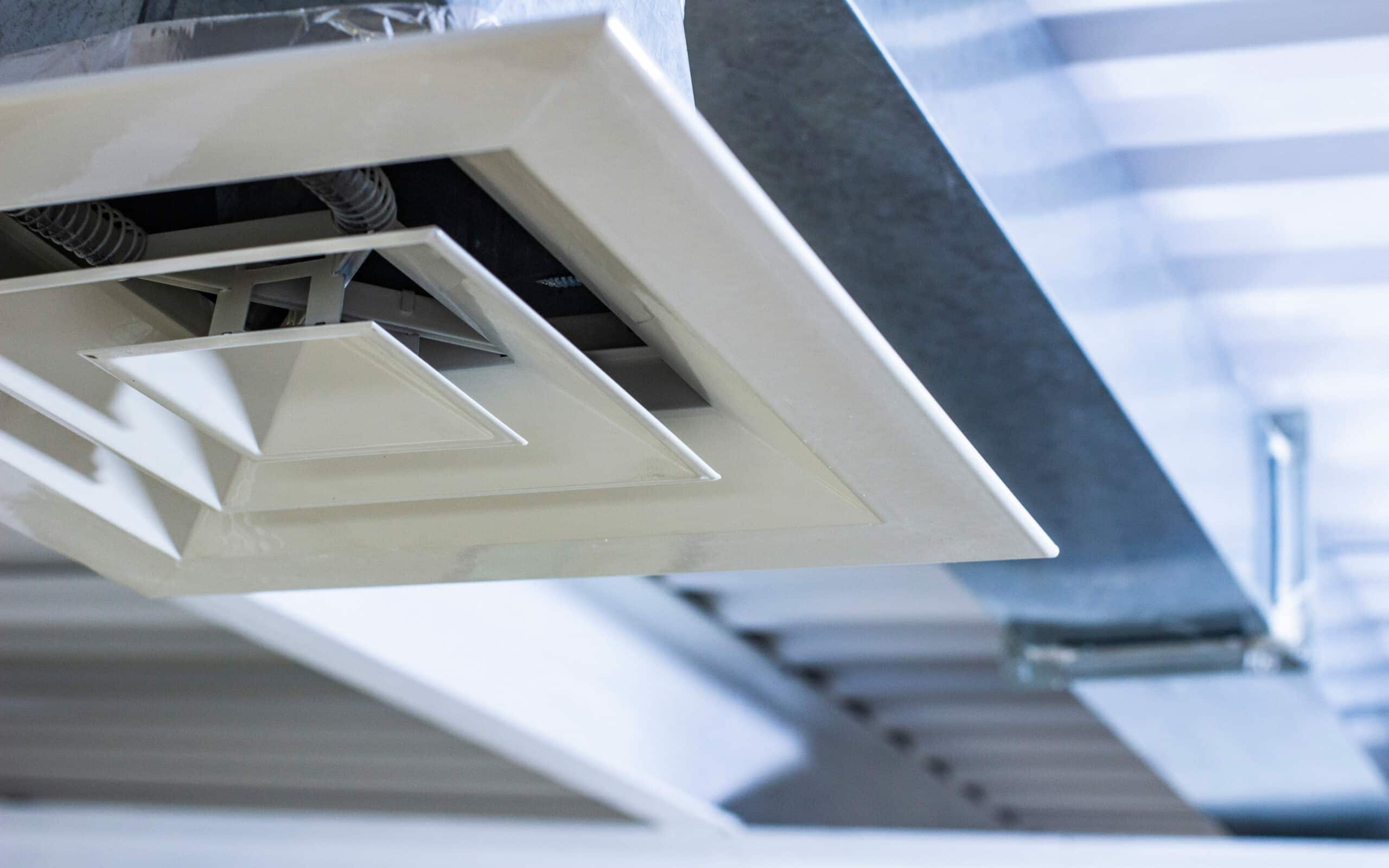
One major part of maintaining good indoor air quality is making sure your space is properly ventilated. Good ventilation can dilute or even eliminate harmful pollutants altogether. Often, an HVAC technician will be able to advise you regarding best practices for air turnover rate and organizing the space for good airflow. In some cases, it may be best to rework the existing HVAC system to make sure a home or building is properly ventilated. Although this can be expensive, it may be necessary to maintain the safety of building occupants.
Air Turnover Rate
If you are not able to eliminate the source of a pollutant, it’s best to at least make sure the area is ventilated and remove as much bad air as possible. To do this, you want to increase the air turnover rate in a given space. This means bringing in more fresh air while pushing out more contaminated air. The faster you do this, the less time your occupants spend breathing indoor air that may contain harmful pollutants.
Think of it like water. Rivers are usually much cleaner than ponds because they are constantly moving. Water in a pond is usually covered in algae because it is stagnant and does not receive new water unless it rains.
It is the same thing with indoor air. If not constantly exchanged, it can quickly become stagnant, allowing biological contaminants to affect your indoor air quality. This is especially true when people are exhaling carbon dioxide and carrying other pollutants into the room all day.
To achieve a higher turnover rate, you will need to make good use of mechanical ventilation systems with plenty of fans and exhaust vents. With this, be sure to keep budgets in mind. The use of fans and motors will certainly require a lot more energy than letting the air be exchanged naturally.
Airflow
When possible, take time to rework your indoor space and remove any obstacles that may block good airflow.
To optimize your indoor spaces, try to create a consistent laminar airflow and prevent backdrafts. This means that the stream of air is focused in one direction, with no side streams or unintentional diversions that spread particles throughout the space unexpectedly. To make this possible, you not only want to consider obstacles like appliances, doors, partitions, or curtains, but also seal up any leaks in floors, walls, or air vents.
During the COVID-19 pandemic, many public spaces such as restaurants started using partitions between tables to prevent the spread of disease across small spaces. While these were effective in stopping particles by creating a solid barrier, improperly placed partitions can block air from flowing smoothly throughout the room and inevitably contribute to a poor air turnover rate.
HVAC Systems
Both airflow and your air turnover rate are important things to consider when installing or reworking HVAC systems. Normal systems that only regulate temperature may not always do the best job at ventilation. That’s why it’s important to tailor your existing system when possible to better balance efficiency, comfort, and air quality. While a trained technician will usually be doing this job for you, it’s good to know a few tips to make sure your indoor air remains safe.
First, think about where you place your exhaust and supply vents as well as what you place near them. Supply vents should be carefully placed so that you know you have the best chance of clean air coming into the ducts. For instance, you probably don’t want to place a supply vent or a return air vent above a dumpster or in a bathroom. If so, trash particles or even fecal matter could be distributed throughout the rest of the building.
Ideally, fans in the kitchen and bathroom should exhaust directly to the outside. This prevents the spread of things trapped in those fans or filters from spreading around the building. It also creates a better airflow. The same goes for other types of exhaust fans. If you can put a fan in the attic that constantly pushes air up through the roof, that will also create a good airflow and turnover rate for the whole building.
Filtration
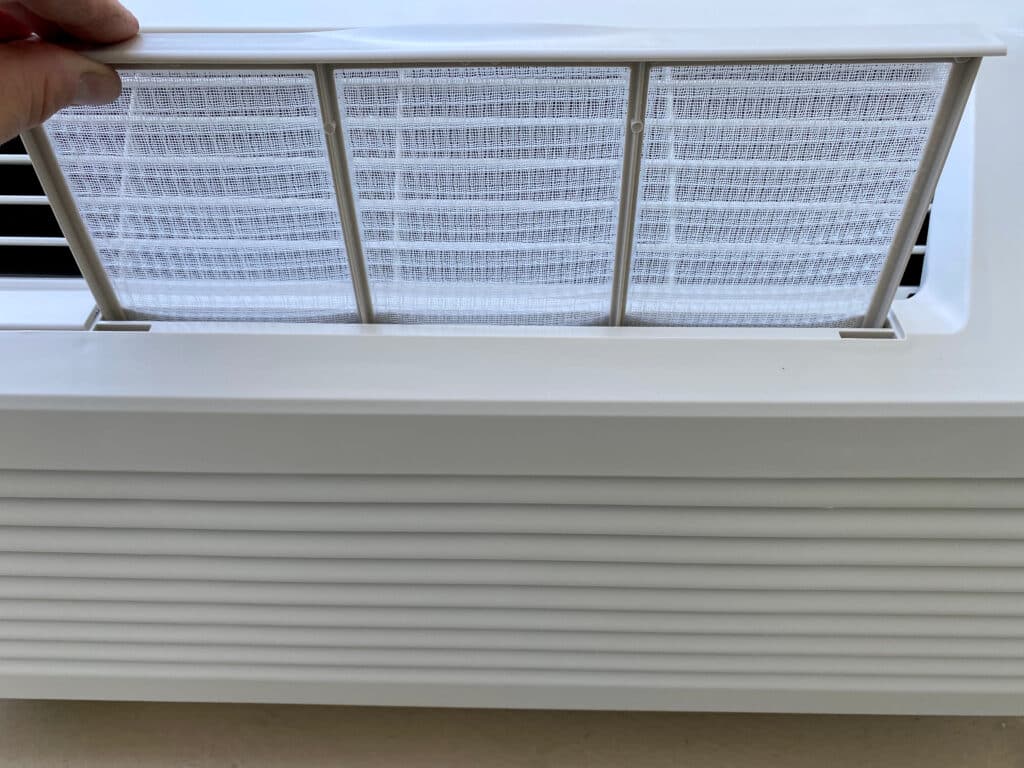
Filtration is a key part of maintaining good indoor air quality. Air filters are usually installed in a return air duct that is easily accessible. From this location, filters work by trapping pollutants such as pollen and dust that would otherwise be circulating through your indoor air.
There are 3 types of filters that are worth considering, depending on your unique space, each with its own advantages. Whichever type you choose, you will want to change out your filters every 30 to 60 days, or as recommended by the instructions on your specific filter. If not, harmful pollutants can build up in the filter and spread throughout the house, making the air even worse than before.
HEPA Filters
HEPA stands for High-Efficiency Particulate Air. This is probably the best type of filter available to consumers and businesses alike. They are powerful because they can remove particles as small as 0.3 microns. This means it can capture things like dust, pollen, mold, and even some viruses. While HEPA filters are typically made of polypropylene, some are outfitted with carbon filtration, which allows them to capture certain types of gases.
While HEPA filters are great for maintaining good indoor air quality, they are also some of the most expensive on the market.
MERV Filters
MERV is another type of air filter rating which stands for Minimum Efficiency Reporting Value. Ranging from a MERV rating of 1 to 20, with each consecutive level rated to capture more types of air pollutants than the last. For instance, a MERV 6 is good for capturing things like dust or pollen, while a MERV 8 will capture both of those along with mold and dust mites.
Most experts agree that a MERV 7 or higher should be standard among all HVAC systems. That said, with a higher MERV rating, your filtration will only improve. For areas with high risk of air pollution, it’s best to use either a MERV 11 (rated for lead, smoke, and pet dander), MERV 13 (rated for many bacteria and viruses), or higher.
Because MERV filters are not usually as strong as HEPA filters, they are also typically more affordable.
Plant-Based Filters
While not commonly used, there are some plant-based air filters on the market that often work just as well as a standard MERV 7 or higher. The advantage to using a plant-based filter is that many of them are washable, meaning you do not have to dispose of them as often as you would the other two other types. They have also proven to do well after multiple washes with no decrease in performance.
Important Technology
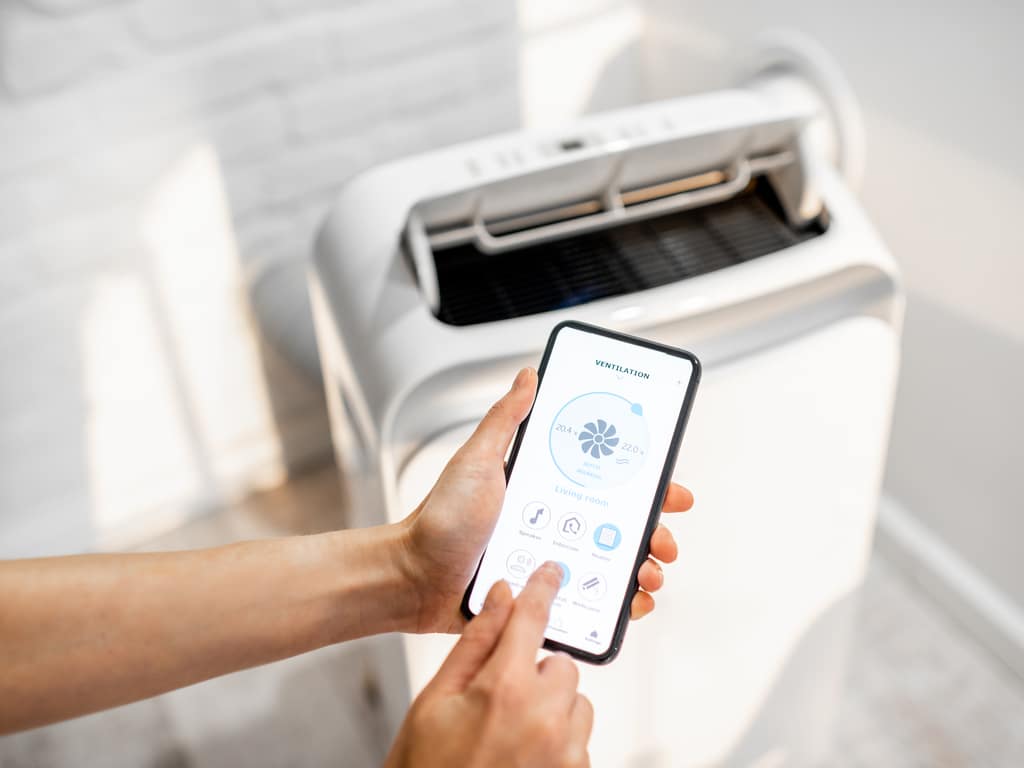
As time goes on, we continue to develop more innovative technology that can fight against air pollutants. Although some products may be experimental and even ineffective overall, a few of them have become integral to maintaining indoor air quality in a variety of spaces. That said, some air technology can be expensive, so consider the needs of the space and how certain products could best help you toward better air quality overall.
Air Purifiers / Air Scrubbers
When trying to improve your indoor air quality, what’s better than a machine that literally cleans the air for you? Typically installed in a duct system, air purifiers and scrubbers prevent dust buildup in the air while eliminating things like pollen, allergens, and even some more dangerous pollutants. This is why air purifiers and scrubbers are popular in many indoor spaces.
However, it’s important to note that an air cleaner is no replacement for eliminating pollutants at the source. If your room is suffering from mold pollution or dust, it’s better to get rid of the mold and regularly dust the area. After that, air purifiers certainly won’t hurt to purify what’s left of any contaminated air.
In spaces with low ventilation, you may not see much of a change in air quality until that aspect is improved. However, an air purifier or scrubber can certainly help improve spaces where high ventilation is not possible.
Dehumidifiers
Because humidity can have a direct effect on the presence of certain air pollutants like mold and dust, dehumidifiers often play an important role in maintaining good IAQ. These machines work by pulling air across a set of coils and allowing the condensation to run down into a sort of drip pan, effectively removing moisture from the room.
By keeping humidity between 35% and 50%, you can help your air conditioning system run with higher efficiency while also preventing the buildup of mold. Because humidity can also cause paint to peel, using a dehumidifier can also prevent harmful paint dust from entering the air.
UV Light
UV lights have commonly been used to purify the air in hospitals since the age of the Spanish Flu. This is because UV light destroys organic pollutants like bacteria, viruses, and mold spores.
To prevent direct exposure to humans, UV lights are normally installed inside the ducting systems so that they clean the air before it enters a room. However, some types of UV light (like UVC) have been deemed safe for human contact. Because of this, you may find UVC lights installed in overhead lamps to actively purify a space where people are present.
Air Quality Monitors
Smoke detectors and CO detectors are standard monitoring devices that should be found in any home or building. Beyond that, there are some more complex machines that can continuously monitor a space’s air quality for a variety of contaminants. Air quality monitors do just that, and usually provide IAQ reports to a smartphone app or other digital interface.
While they do not necessarily do anything to treat the problem, using an air quality monitor can quickly save money on testing supplies and provide a more complete picture of the IAQ for your building.
PTACs
Although it isn’t always obvious, PTACs (Packaged Terminal Air Conditioners – low, sleek, in-wall A/C units) play an important role in maintaining good indoor air quality as well. This is why many hotels and hospitals use PTACs in their individual rooms.
While they do offer more direct control over a room’s temperature, they also provide a more controlled air environment. That’s because the air circulating through a PTAC is individual, not part of a larger HVAC system. In other words, the air that flows through a PTAC is not shared by any other room in the building.
Because PTACs are also ductless (installing directly into an outside wall), turnover rate is usually higher than that of a standard duct system. This means more fresh air from outdoors can circulate in while old air from the room is being pushed out.
That said, there are a lot of different PTAC models to choose from. When making a selection, be sure your model is the correct size for the room you’d like to install it in.
Final Thoughts
Indoor air quality is tremendously important for anyone in any kind of space. As we start spending more time indoors, working from home and staying safe from any new viral threats, the air we breathe will become more and more of a concern.
Although there are a lot of things to consider when trying to make your indoor spaces safer and more comfortable for occupants, the first step is to educate yourself. That doesn’t mean you have to be an HVAC technician or a scientist in order to make an impact. The EPA has great resources available that can help you better understand threats to your home atmosphere and start taking steps toward better indoor air quality all around.
If you are looking to save money on better HVAC technology and improve the air quality of your indoor space, consider a PTAC unit as your first investment toward that goal. At PTAC4Less, we have a variety of new and refurbished models available with guides that can help you choose which one works best for you. See what we have to offer in our online shop.
